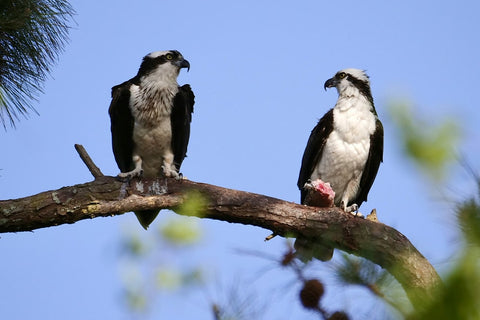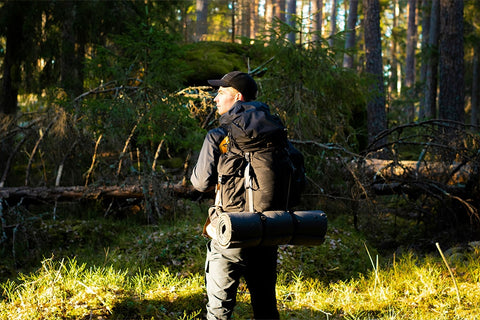It's a crisp spring morning and as you take another sip of your coffee, you scroll through the images your new wildlife camera captured last night. You might expect some moving branches or perhaps a stray cat, but then you come across something fascinating. There, captured in the dark of night, is a beautiful deer walking carefully through your garden. Or maybe it's a curious rabbit that comes sniffing around. You suddenly realize that there is a whole world of wildlife activity happening in your own backyard, a world that had remained hidden until now.
How do the professionals do it?
We often wonder how biologists and conservationists capture those amazing images of wildlife? The answers are closer than we think. With the help of WiFi-enabled wildlife cameras, it is now possible for both professionals and amateurs to explore and document the secret lives of animals around us.
The bridge between people and nature
But how exactly? How can these cameras help us get closer to nature and even contribute to nature conservation from our own backyard? We take you on a journey through the world of wildlife cameras, highlighting how these technological wonders have not only become essential for professional biologists, but how, with a wildlife camera in your hands, you can open the door to amateur biology wide. Let's dive together into the how and why of wildlife cameras and discover how they can help us understand and appreciate the natural world on a deeper level.
The silent guardians of the wilderness
Wildlife cameras, with their advanced WiFi technology, have made the way we study nature much easier. By remotely accessing the images captured by these cameras, researchers and conservationists can now unravel the secrets of the animal kingdom without any disruption. These technological advances provide an unprecedented glimpse into animal life in their natural habitat.
Data without Borders
The ability to collect real-time data opens new horizons in nature research. WiFi- enabled wildlife cameras allow scientists to observe behavioral patterns, map migration routes and even monitor rare or shy species that were previously nearly impossible to capture. All this with minimal human intervention, keeping the impact on nature as small as possible.
Progress in conservation
These cameras are not just instruments for observation; they are allies in the conservation of biodiversity. By providing crucial information about endangered species and their habitats, WiFi-enabled wildlife cameras support the development of more effective conservation plans. They play a key role in protecting ecosystems, helping us understand how we can better preserve our natural world for future generations.

Moments that Changed the World
In the wake of Australia's devastating Black Summer bushfires, the Eyes on Recovery project has shone a light on nature's resilience. This unique initiative, a collaboration between WWF, Conservation International and supported by Google, uses more than 1,100 motion-activated wildlife cameras with Wi-Fi to record the recovery of animals in their natural habitats.
Key Insights:
- The project started three years after the catastrophic bushfires of 2019-2020.
- With more than 7 million photos collected, it offers a unique perspective on the return of animal species, such as koalas and wombat mothers with their young.
- It reveals the unprecedented resilience of native species, which have seen up to 90% of their habitat lost.

Special bird observations by The Nature Conservancy
Through the use of camera traps and livestream cameras, The Nature Conservancy has captured notable bird species in several parts of the United States, including New Jersey, the Great Salt Lake and Missouri. This technology has added a new dimension to understanding and protecting these birds and their natural environment.
Notable Discoveries:
- The observation of ospreys along the New Jersey coast and American kestrels near the Great Salt Lake.
- Unique footage of the mating rituals of Missouri's greater prairie chickens, shedding light on their complex social behavior.
- These observations contribute essential to identifying threats to their habitats and developing targeted protection strategies.

Animals in the Dangermond Preserve
The Dangermond Preserve, a conservation area in California managed by The Nature Conservancy, is home to a rich variety of wildlife. Wi-Fi-enabled motion-activated wildlife cameras have provided deep insights into the animals' daily lives and movement patterns, improving the management and protection of this unique ecosystem.
Insights and Observations:
- The cameras have recorded the presence of several mammal species such as mountain lions, bobcats and coyotes.
- They provide a detailed picture of how these animals interact within the reserve and how they respond to the seasonal changes in their environment.
- The recording of invasive feral pigs during the summer months has provided crucial information for the management of these species within the reserve.
The use of advanced wildlife cameras with WiFi has enabled us to capture unique moments in nature, which are crucial for understanding and protecting our world. These moments, captured in remote and pristine areas, highlight the important role of technology in documenting and preserving the planet's biodiversity.
From viewer to researcher
The magic of wildlife cameras lies not just in capturing what passes by, but in unraveling the stories that each species carries. If you're already familiar with the basics of placing and setting up your wildlife camera , now is the time to take your knowledge and skills to the next level.
Build a wildlife camera network:
- Consider placing multiple cameras strategically for a comprehensive view of animal movements and interactions. Analyze how the different species influence each other and shape the ecosystem.
- Take advantage of advanced features like WiFi connectivity to receive real-time notifications and manage your cameras remotely, allowing you to respond immediately to events of interest.
Refine your research techniques
With a deeper understanding of wildlife cameras comes the responsibility to approach the natural world ethically and respectfully. This means refining your techniques to have the least impact while collecting the richest data.
Focus on behavioral studies:
- Plan long-term observation projects to gain insight into behavioral patterns, such as migration, feeding and reproduction. These in-depth studies can provide unexpected insights and contribute to scientific knowledge.
- Collaborate with scientists and conservation organizations by sharing your findings and images. Your unique perspective as an amateur can provide valuable data that professionals may overlook.
Making an impact with every shot
Your commitment to nature conservation doesn't have to stop at observation. Use your passion and your platform to create awareness and inspire others to action.
Document and share the stories:
- Create compelling stories around your observations. Whether it's a blog post, a social media campaign or a presentation to your community, every story has the power to touch and motivate others.
- Involve your network in citizen science projects or habitat restoration initiatives. Your images can provide the evidence needed to underline the need for protective measures.
This approach transforms you from an observer to an influential voice in the world of conservation. Your wildlife camera journey not only provides personal fulfillment, but also contributes to greater understanding and protection of our natural world. Your actions, no matter how small, have the potential to create major waves of change in the fight to preserve our planet for future generations.

Are you the next Freek Vonk?
In addition to a quality wildlife camera, there are some essential tools you can use to take your nature research to the next level:
- Binoculars: For spotting birds and other animals from a distance, without disturbing them.
- Notebook or digital app: To record observations, behavior and locations. Apps like iNaturalist help identify species and share your findings with a community of nature lovers.
- Field Guides: Books or apps about local flora and fauna for quick reference and identification.
- Weatherproof clothing and shoes: To stay comfortable and protected during your explorations, whatever the weather.
Collaborating with nature organizations in the Netherlands
In the Netherlands there are various organizations and initiatives that you can join as an amateur biologist to contribute to nature conservation and research:
- Natuurmonumenten: Offers volunteer and citizen science projects you can participate in, ranging from bird counts to monitoring specific habitats.
- IVN (Institute for Nature Education): Organizes courses and activities aimed at deepening knowledge about nature and how you can actively contribute to nature conservation.
- Waarneming.nl: A platform where you can share your observations, thereby contributing to knowledge about biodiversity in the Netherlands. The platform is also used by scientists for research purposes.
- Butterfly Foundation or Bird Protection Netherlands: Specific organizations focused on the conservation of butterflies or birds. These organizations often have projects running where the help of volunteers is indispensable.
Practical tips for the field
- Plan your observations: Take seasonal changes and animal migration patterns into account. For example, some species can only be seen in certain seasons.
- Respect nature: Stay on the paths, do not disturb animals and do not leave litter behind. Your presence should have as little impact as possible on the natural environment.
- Network with like-minded people: Join local nature associations or online forums to share experiences and learn from each other.
By following these steps and using the right resources, you as an amateur biologist can make a valuable contribution to research and protection of nature in the Netherlands. Your passion and commitment are crucial for the conservation of our biodiversity.
From passion to action: Protect our nature
With every wildlife camera we set up, we not only unlock the secrets of the wild, but we also take a step towards active participation in nature conservation. WildcameraXL offers you the key to this journey of discovery, with advanced technology that enables every nature lover to contribute to the well-being of our planet.
Make a difference with your wildlife camera
Now is the time to embrace your role in the bigger picture. Our wildlife cameras are your instrument for change. Choose your ally in nature conservation today at WildcameraXL and take your first step from hobbyist to protector of our natural treasures.
By choosing a wildlife camera, you not only connect to the wonders of nature, but you also become a crucial voice in the call for its protection. Go out armed with the knowledge and technology needed to make a difference. Together we build a future in which people and nature live together in harmony.
